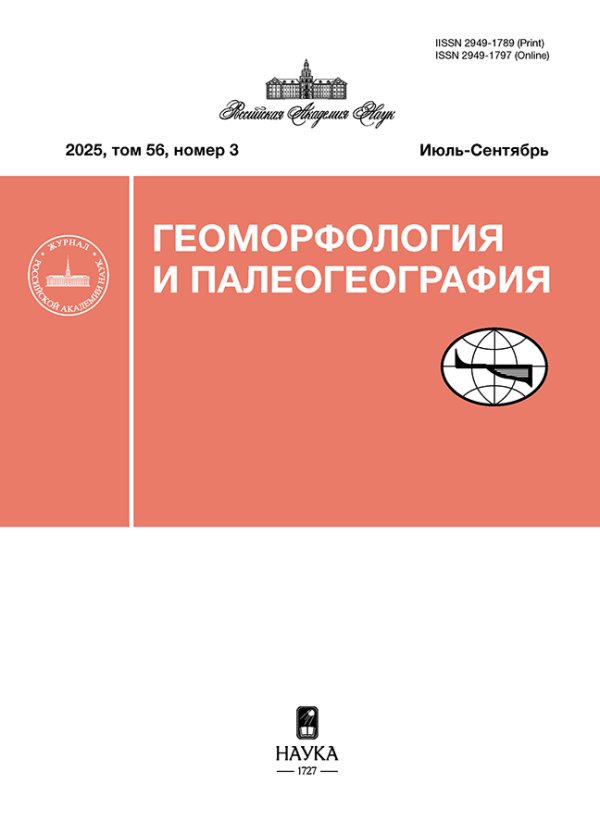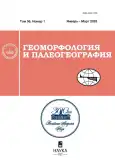Relict cryogenic microrelief of the Zavolzhye-Urals region
- Authors: Ryabukha A.G.1, Streletskaya I.D.2, Polyakov D.G.1, Kovda I.V.3
-
Affiliations:
- Institute of Steppe of the Ural Branch of the RAS
- Lomonosov Moscow State University, Faculty of Geography
- Dokuchaev Soil Science Institute
- Issue: Vol 56, No 1 (2025): SPECIAL ISSUE
- Pages: 161-180
- Section: THE CASPIAN SEA IN THE PLEISTOCENE: EVOLUTION OF THE NATURAL ENVIRONMENT AND HUMANS
- URL: https://bakhtiniada.ru/2949-1789/article/view/305387
- DOI: https://doi.org/10.31857/S2949178925010099
- EDN: https://elibrary.ru/dntbux
- ID: 305387
Cite item
Abstract
The article is devoted to the study and analysis of the microrelief of the Zavolzhye-Urals region on the elevated erosion-denudation surfaces of the East European Plain (Bugulminsko-Belebeevskaya Upland, Obshchy Syrt and the Subural plateau), denudation basement plains of the southern Trans-Urals (Uralo-Tobolsk plateau) and low mountains of the Southern Urals. The leading role of relict cryogenic processes in its formation is assumed. The morphological and morphometric indicators of the relict permafrost relief (polygonal-block; longitudinal-strip (delley); merged-polygonal and reduced; hilly-depressions microrelief, etc.) are described, and new types of relict cryogenic microrelief (RCM) for the Zavolzhye-Urals region are established and characterized for the first time. The uniqueness of the paleocryogenic genesis of landscape complexes to the steppe zone is confirmed. In drained areas composed of Upper Cretaceous rocks, the microrelief is represented by “chalk polygons”; in areas composed of dispersed rocks – “tufurs”; on Trans-Ural variegated weathering crusts of loamy-clayey composition – “palsa”, on gypsisol- hilly-depressions forms. For the first time in the steppe zone, beaded streams forms have been identified as a type of relict cryogenic relief. The connection has been established between areas with various types of paleocryogenic microrelief and modern relief, geomorphological position and composition of surface sediments. The result of this research was the map-scheme “Relict cryogenic microrelief of the Zavolzhye-Urals region” on a scale of 1:2 500 000.
About the authors
A. G. Ryabukha
Institute of Steppe of the Ural Branch of the RAS
Author for correspondence.
Email: annaryabukha@yandex.ru
Orenburg, Russia
I. D. Streletskaya
Lomonosov Moscow State University, Faculty of Geography
Email: annaryabukha@yandex.ru
Moscow, Russia
D. G. Polyakov
Institute of Steppe of the Ural Branch of the RAS
Email: annaryabukha@yandex.ru
Orenburg, Russia
I. V. Kovda
Dokuchaev Soil Science Institute
Email: annaryabukha@yandex.ru
Moscow, Russia
References
- Alifanov V.M., Gugalinskaya L.A., Ovchinnikov A.Yu. (2010). Paleokriogenez i raznoobrazie pochv tsentra Vostochno-Evropeiskoi ravniny (Paleocryogenesis and soil diversity in the center of the East European Plain). Moscow: GEOS (Publ.). 178 p. (in Russ.)
- Aubekerov B.Zh. (1990). Cryogenic structures and cryolithozones of the Pleistocene of Kazakhstan. Izvestiya AN SSSR. Seriya geograficheskaya. No. 4. P. 10–110. (in Russ.)
- Belyaev Yu.R., Panin A.V., Bronnikova M.A. et al. (2021). Development of the western part of the Turan-Uyuk basin (Tuva highland) in the Late Quaternary. Geomorfologiya. Vol. 52. No. 4. P. 15–27. (in Russ). https://doi.org/10.31857/S0435428121040040
- Berdnikov V.V. (1976). Paleokriogennyi mikrorel’ef Tsentra Russkoi ravniny (Paleocryogenic microrelief of the Center of the Russian Plain). Moscow: Nauka (Publ.). 124 p. (in Russ.)
- Boguckij A.L., Velichko A.A., Nechaev V.P. (1975). Paleocryogenic processes in western Ukraine in the Upper and Middle Pleistocene. In: Problemy regional’noi i obshchei paleogeografii lessovykh i periglyatsial’nykh oblastei. Moscow: Institut geografii AN SSSR (Publ.). P. 80–90. (in Russ.)
- Bojcov M.N. (1959). About relics of permafrost relief on the eastern slope of the Southern Urals. In: Informatsionnyi sbornik. Leningrad: VSEGEI (Publ.). No. 15. P. 55–66. (in Russ.)
- Bojcov M.N. (1961). Traces of periglacial phenomena on the eastern slope of the Southern Urals. In: Materialy po geologii Urala. Leningrad: VSEGEI (Publ.). P. 107–128. (in Russ.)
- Butakov G.P. (1986). Pleistotsenovyi periglyatsial Russkoi ravniny (Pleistocene periglacial of the Russian Plain). Kazan’: Kazanskii un-t (Publ.). 144 p. (in Russ.)
- Dostovalov B.N. (1960). Patterns of development of tetragonal systems of ice and ground veins in dispersed rocks. In: Periglyatsial’nye yavleniya na territorii SSSR. Moscow: MGU (Publ.). P. 122–156. (in Russ.)
- Eremenko E.A., Fuzeina Yu.N., Derkach A.A. et al. (2020). Relict cryogenic relief of the north of the Kaliningrad region. In: Materialy VIII Vserossiiskoi konferentsii s mezhdunarodnym uchastiem “Shchukinskie chteniya: rel’ef i prirodopol’zovanie”. Moscow: MGU (Publ.). P. 306–313. (in Russ.)
- Ermolin E.D. (1985). Permafrost relief of Northern and Central Kazakhstan. In: Regional’nye i inzhenernye geokriologicheskie issledovaniya. Yakutsk: IM SO RAN (Publ.). P. 91–101. (in Russ.)
- Fedorovich B.A. (1962). Permafrost formations in the steppes and semi-deserts of Eurasia. In: Voprosy stratigrafii i paleogeografii chetvertichnogo perioda (antropogena). Moscow: AN SSSR (Publ.). P. 70–100.
- Fotiev S.M., Danilova N.S., Sheveleva N.S. (1974). Geokriologicheskie usloviya srednei Sibiri (Geocryological conditions of central Siberia). Moscow: Nauka (Publ.). 148 p. (in Russ.)
- Garankina E.V., Lobkov V.A., Shorkunov I.G. et al. (2021). Relict cryogenic morphosculpture in sections and relief of the Borisoglebskaya Upland. In: Materialy II Vserossiiskoi nauchnoi konferentsii, posvyashchennoi pamyati professora A.A. Velichko “Puti evolyutsionnoi geografii – 2021”. Vol. 2. Moscow: IG RAN (Publ.). 2021. P. 85–90. (in Russ.)
- Gorbunov A.P., Severskij E.V. (2015). Cryogenic relics of the Pleistocene in Kazakhstan. Voprosy geografii i geoekologii. No. 2. P. 26–35. (in Russ.)
- Gorbunova I.A. (1998). Relict cryogenic structures of Northern and Central Kazakhstan and their influence on modern soil cover. In: Regional’nye problemy ekologii, geografii i kartografii pochv. P. 176–188. (in Russ.)
- Gorodeckaya M.E. (1958). Witnesses of former permafrost in the Pavlodar region. Izvestiya AN SSSR. Seriya geograficheskaya. No. 5. P. 65–72. (in Russ.)
- Kachurin S.P. (1961). Termokarst na territorii SSSR (Thermokarst on the territory of the USSR). Moscow: AN SSSR (Publ.). 291 p. (in Russ.)
- Kamyshev A.A., Kyrakova A.A., Tarbeeva A.M. (2024). Distribution and morphometric characteristics of beaded channels in the northern part of the steppe zone of the Russian Plain. Geomorfologiya i Paleogeografiya. Vol. 55. No. 4. P. 129-143. (in Russ.). https://doi.org/10.31857/S2949178924040089
- Kaplina T.N., Romanovskij P.N. (1960). About pseudomorphoses on polygonal ice. In: Periglyatsial’nye yavleniya na territorii SSSR. Moscow: Nauka (Publ.). P. 47–59. (in Russ.)
- Larin S.I., Alekseeva V.A., Lauhin S.A. et al. (2020). Features of the formation of the composition of relict soil veins at the base of cover deposits of the forest-steppe Tobol region. Earth’s Cryosphere. Vol. XXIV. No. 4. P. 5–16. (in Russ.) https://doi.org/10.21782/KZ1560-7496-2020-4(5-18)
- Makeev A.O. (2012). Poverkhnostnye paleopochvy lessovykh vodorazdelov Russkoi ravniny (Surface paleosols of loess watersheds of the Russian Plain). Moscow: Molnet (Publ.). 258 p. (in Russ.)
- Molodyh I.I. (1988). Grunty podov i stepnykh blyudets subaeralʹnogo pokrova Ukrainy: Gidrogeologicheskie i inzhenerno-geologicheskie osobennosti (Soils of hearths and steppe saucers of the subaerial cover of Ukraine: Hydrogeological and engineering-geological features). Kiev: Naukova dumka (Publ.). 159 p. (in Russ.)
- Moskvitin A.I. (1962). Pleistotsen Nizhnego Povolzh’ya (Pleistocene of the Lower Volga region). Moscow: Izd-vo AN SSSR (Publ.). 263 p. (in Russ.)
- Musihin G.D. (1996). Soil-forming rocks of the Orenburg region. In: Problemy stepnogo prirodopol’zovaniya (ekologiya, plodorodie i ratsional’noe ispol’zovanie pochv). Orenburg: Dimur (Publ.). P. 70–78. (in Russ.)
- Popov A.I. (1960). Periglacial formations of Northern Eurasia and their genetic types In: Periglyatsial’nye yavleniya na territorii SSSR. Moscow: MGU (Publ.). P. 10–36. (in Russ.)
- Popov A.I. (1962). Cover loams and polygonal relief of the Bolshezemelskaya tundra. In: Voprosy geograficheskogo merzlotovedeniya i periglyatsial’noi morfologii. Moscow: MGU (Publ.). P. 109–130. (in Russ.)
- Popov A.I., Rozenbaum G.E., Tumel’ N.V. (1985). Kriolitologiya (Cryolithology). Moscow: MGU (Publ.). 239 p. (in Russ.)
- Popov A.I. (Eds.). (1989). Regional’naya kriolitologiya (Regional cryolithology). Moscow: MGU (Publ.). 256 p. (in Russ.)
- Porozhnyakova O.M. (1979). Relict cryogenic microrelief of the southern part of the Bryansk region. Geomorfologiya. No. 3. P. 86–93. (in Russ.)
- Rogov V.V., Streleckaya I.D., Taratunina N.A. et al. (2020). Late Pleistocene cryogenesis in the Lower Volga region. Vestnik Moskovskogo universiteta. Seriya 5. Geografiya. No. 6. P. 73–85. (in Russ.)
- Romanovskij N.N. (1977). Formirovanie poligonal’no-zhil’nykh struktur (Formation of polygonal vein structures). Novosibirsk: Nauka (Publ.). 213 p. (in Russ.)
- Ryabukha A.G., Polyakov D.G., Streleckaya I.D., Kovda I.V. (2023). Relict cryogenic structures in the landscapes of the Zavolzhye-Urals region. In: Materialy vserossiiskoi konferentsii “Kaspii v plejstotsene i golotsene: evolyutsiya prirodnoi sredy i chelovek”. Moscow: Pero (Publ.). P. 159–163. (in Russ.)
- Ryabukha A.G., Streletskaya I.D., Polyakov D.G. et al. (2021). Relict cryogenic structures in the Orenburg region landscapes. In: IOP Сonference Series: Earth and Environmental Sci. 817. 012093. https://doi.org/10.1088/1755-1315/817/1/012093
- Ryzhov Yu.V., Golubcov V.A. (2018). Cryogenesis and development of erosional landforms in the forest-steppe landscapes of the Selenga midlands in the Late Glacial and Holocene. Geomorfologiya. No. 2. P. 89–98. (in Russ.) https://doi.org/10.7868/S0435428118020074
- Semochkina A.E., Belyaev V.R., Garankina E.V. et al. (2020). Relict cryogenic microrelief of the Kursk and Yaroslavl regions. In: Materialy VIII Vserossiiskoi konferentsii s mezhdunarodnym uchastiem “Shchukinskie chteniya: rel’ef i prirodopol’zovanie”. Moscow: MGU (Publ.). P. 363–368.
- Sharp R.Р. (1942). Soils structures in the St. Elias Range, Yukon Territory. J. Geomorphology. Vol. 5. No. 5. Р. 274–301.
- Shkatova V.K., Nikulin A.G. (1998). Loess-soil stratigraphy of the Orenburg Cis-Urals. In: Materialy vserossiiskogo soveshchaniya “Glavneishie itogi v izuchenii chetvertichnogo perioda i osnovnye napravleniya issledovanii v XXI veke”. Sankt-Peterburg: VSEGEI (Publ.). P. 57–58.
- Sycheva S.A. (2012). Paleomefrost events in the periglacial region of the Central Russian Upland at the end of the Middle and Late Pleistocene. Kriosfera Zemli. Vol. XVI. No. 4. P. 45–56. (in Russ.)
- Taratunina N.A., Rogov V.V., Lebedeva M.P. et al. (2024). Stratigraphy, chronology and paleogeography of Late Quaternary cryogenesis in Northern Caspian Lowland. Geomorfologiya i Paleogeografiya. Vol. 55. No. 3. P. 5–31. (in Russ.). https://doi.org/10.31857/S2949178924030018
- Tarbeeva A.M. (2018). On the origin of beaded river channels shape in the permafrost zone. Geomorfologiya. No. 2. P. 88-95. (in Russ.) https://doi.org/10.7868/S043542811801008X
- Tarbeyeva A.M., Krylenko I.V., Surkov V.V. Lake-like extensions of the riverbeds in the steppe zone and possible causes of their formation (on the example of the Ural River basin near city of Orsk). Geomorfologiya. No. 1. P. 73-81. (in Russ.). https://doi.org/10.15356/0435-4281-2016-1-73-81
- Vandenberghe J., French H.M., Gorbunov A. et al. (2014). The Last Permafrost Maximum (LPM) map of the Northern Hemisphere: permafrost extent and mean annual air temperatures, 25–17 ka BP. Boreas. Vol. 43. Iss. 3. P. 652–666. https://doi.org/10.1111/bor.12070
- Velichko A.A. (1965). Cryogenic relief of the Late Pleistocene periglacial zone (cryolithozone) of Eastern Europe. In: Chetvertichnyi period i ego istoriya. Moscow: Nauka (Publ.). P. 104–120. (in Russ.)
- Velichko A.A. (1973). Prirodnyi protsess v Pleistotsene (Natural process in the Pleistocene). Moscow: Nauka (Publ.). 256 p. (in Russ.)
- Velichko A.A., Morozova V.P., Nechaev O.M. et al. (1996). Paleokriogenez, pochvennyi pokrov i zemledelie (Paleocryogenesis, soil cover and agriculture). Moscow: Nauka (Publ.). 150 p. (in Russ).
Supplementary files










